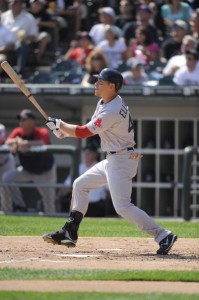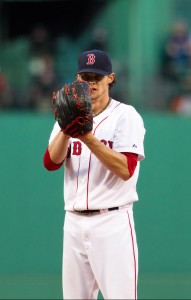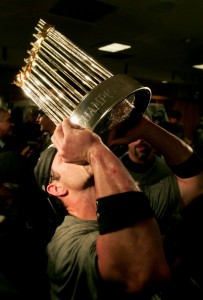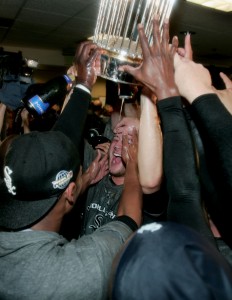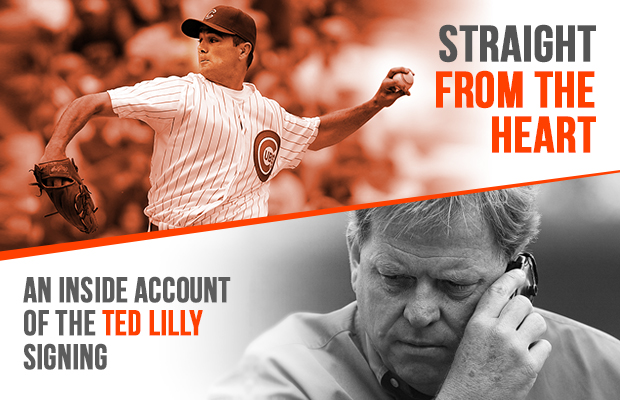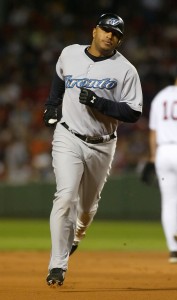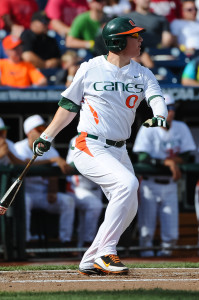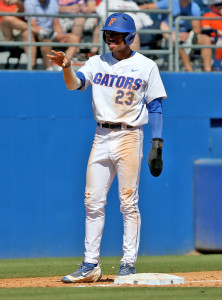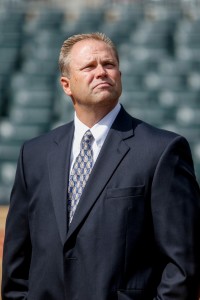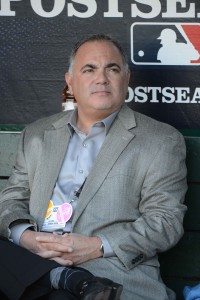The way things are shaping up, the 2009 Los Angeles Angels of Anaheim draft would have to be considered a good one even if the 25th pick belonged to somebody else. When three starting pitchers (including two southpaws) and a power-hitting position player reach and produce at the major league level, it makes for a nice haul.
The team’s first selection, Randal Grichuk, is now a starting outfielder for the Cardinals – and is coming off a 24-homer season as a 24-year-old.
Supplemental first-rounders Tyler Skaggs and Garrett Richards were members of the Angels’ season-opening starting rotation. Second-round pick Patrick Corbin is the Diamondbacks’ No. 2 starter.
But then, of course, there is the matter of the Angels having the 25th pick that year. And you can very easily picture Commissioner Bud Selig walking to the podium and making his announcement: “With the 25th selection in the first round of the 2009 First-Year Player Draft, the Los Angeles Angels of Anaheim select Michael Trout.”
“I’ve never seen a team walk out of a draft and think they had a bad draft,” said Eddie Bane, the Angels’ scouting director from 2004-2010 and now a special assignment scout for the Boston Red Sox. “Everybody thinks that their draft was the greatest of all-time every year. Sure, we were guilty of the same thing. I don’t know if guilty is the right word; you just love scouting so much that you think the players you picked are just awesome. That’s the way it works. You think you’re going to help stack the organization; that’s the way everybody thinks. But we actually did. It’s kind of a rarity.”
In 2008, the Angels won a major league-best 100 games and went to the postseason for the fifth time in seven years.
Success on the field was mirrored by the Angels’ frequent forays into free agency, which directly impacted the team’s amateur draft capabilities. Over their previous five drafts, the team gave up seven high-round picks as free agent compensation, losing either a first- or second-round pick every year.
The 2009 draft, from that standpoint, was no different; the Angels surrendered their own No. 1 (No. 32 overall) as compensation for the signing of free agent closer Brian Fuentes.
However, the Angels lost several key players to free agency – closer Francisco Rodriguez (to the Mets), first baseman Mark Teixeira (to the Yankees) and starting pitcher Jon Garland (to the Diamondbacks). Lo and behold, the team had a glut of high-round picks – back-to-back at 24-25, followed swiftly by supplemental selections at 40, 42 and 48.
(Have you forgotten how the old Type A/Type B free agent compensation system worked? Take a trip down memory lane.)
“I started with the Angels in 2004, and we had a pick at 12 and got Jered Weaver. But other than that, we never had anything in the first 25 because we were pretty good and we were more in the shopping business,” said Bane – a no-nonsense, tell-it-like-it-is type whose previous Angels drafts included the selection of future big leaguers Weaver, Nick Adenhart, Mark Trumbo, Peter Bourjos, Hank Conger, Jordan Walden, Tyler Chatwood and Will Smith. “We never thought once about not having a really high pick; that was normal. So we were really excited because we had five picks. We thought that was awesome.”
If you recall, 2009 was the “Year of Strasburg.” The chances of Stephen Strasburg getting past Washington and falling all the way to No. 2 in the draft were largely nonexistent.
“I saw him pitch one time for about 2.0 innings and said, ‘This is a waste of time,’” Bane recalled. “I told the area scout to just make sure he does a good job on Strasburg’s makeup and everything else. You don’t spend a lot of time on Stephen Strasburg when you’re picking 24-25.”
Bane started ruling out others he knew would be gone by the middle of the first round and started focusing on players who he thought could be there for him. One player he was immediately drawn to was a prep outfielder out of Lamar Consolidated High School in Rosenberg, Texas, named Randal Grichuk.
“Jeff Malinoff, one of my national cross-checkers who was as good of a hitting scouting guy as there’s ever been … he loved Randal, as did Kevin Ham, the area scout,” Bane said. “Randal could hit his home runs a long way to right-center and left-center. Obvious power. Good athlete. All that stuff. We thought there would be a chance that he would get there.
“It’s hard to describe to people the excitement you get when you see somebody that not every scout loves, and you see the passion they have for the game, and you file that away. I still remember batting practice; I was there with Jeff, and Randal was hitting rockets out to right-center. With Randal, the body has improved with maturity, but it’s not dramatically different than he was in high school. He was a strong, good athlete that could go get a ball in centerfield. His arm was fine. To me, he looked like a lock first rounder. That’s when you start thinking immediately, ‘Well, he won’t be there when we pick’ – because you think other teams see it exactly the way you do. Fortunately, they don’t.”
And then, of course, there was another prep outfielder that Bane locked in on – this one out of Millville Senior High School in New Jersey. Two MVP seasons and three MVP runner-up campaigns later, it’s still hard to believe that Mike Trout would be available that deep in the draft.
– – –
“The first time I ever talked to (area scout) Greg Morhardt about him, he told me, ‘I got a guy in Jersey for next year’s draft who’s going to go into the Hall of Fame,’ and I started laughing,” Bane said. “I don’t know how many times I’ve heard that kind of statement from mostly parents. Usually, it’s not from a scout. But that’s what Mo said. I laughed about it, but I made sure to remember the name.”
Morhardt, whose territory included New Jersey, New York, Maine, New Hampshire, Vermont, Massachusetts, Connecticut and Rhode Island, was a former minor league first baseman/outfielder. For three years (1984-1986), one of his teammates with Minnesota’s Orlando affiliate in the Double-A Southern League was Jeff Trout – an infielder and future dad of Mike (who was born in 1991).
“Sometimes you have to listen to what people say … all the time, I guess, but then you usually filter it out,” Bane said. “I couldn’t be biased because it was some former player’s kid, and I couldn’t have a bias because the scout knows the guy – and he’s looking at the kid through rose-colored glasses. I had to be aware of that.”
In other words, the relationship between Morhardt and the Trouts could have skewed the scout’s judgement and reports. Bane had to go in with an open mind and witness the same things his area scout was seeing. He did … and then some.
“I go to his high school game with Jeff Malinoff,” he said, “and the kids are working hard and everything, but there’s not a lot of great players on the field. Obviously, you know which one is Mike Trout. They take batting practice, and he was killing balls. They took infield, so you were aware of his instincts out in center.
“The game starts, and this is the part that’s hard for people to believe. He pops up a ball to left-center and runs as hard as he can and ends up at third with a triple because they couldn’t catch it. You mark that down. He had a couple other at-bats, a couple more hits, and then around the fifth inning, I grabbed Malinoff and said, ‘Let’s go.’
“He looked at me like, ‘Oh no. What?’ And I got in the car and told Jeff, ‘If that guy’s there when we’re picking, we’re taking him.’ He said, ‘What went on that I didn’t see?’ And I said, ‘There’s something about this guy.’
“I wanted to learn more about him, so I called up (Morhardt) and told him to set up a dinner with me and the Trout family. He did, and maybe 10-15 days later, we had dinner at some colonial restaurant right outside out of Millville. The dinner was the best dinner impression I ever had as an amateur scout. The mom, Debbie, was incredible. Jeff fooled around with Mike like Mike was nothing special to them. And Mike, you could tell there was a lot of love at that table between those guys; they goofed around on each other and kidded with each other. It was the most impressive thing I saw out of Mike before the draft … the way he interacted with his mother and father.
“When I left the restaurant, I was pumped.”
– – –
Draft day … June 9, 2009.
Heading into the day, it was likely that Grichuk would be there when it was the Angels’ time to pick. But would Trout make it past 23 spots? Only a couple trusted higher-level scouts knew Bane’s pipe-dream scenario of landing both Trout and Grichuk.
“I tried to keep it inward as much as I could; Jeff (Malinoff) and (national cross-checker) Ric (Wilson) knew what I wanted to do,” Bane said. “I was kind of paranoid, and I didn’t want a text message going out to somebody saying ‘Hey, the Angels are looking at two high school outfielders in a row.’ Somebody would know who they were. That’s the paranoid part of having that job.”
Bane didn’t care about taking high school guys back-to-back. There is certainly risk in drafting high school players in the first round, and none of the prep position players taken before Grichuk and Trout that day (No. 3 Donavan Tate, San Diego; No. 16 Bobby Borchering, Arizona; No. 21 Jiovanni Mier, Houston) has seen a day of major league action.
“Now, I’ve read a lot of stuff … people saying, ‘How in the world did they take two high school outfielders in a row?’ That was never the way I looked at it,” Bane said. “I just wanted to take the best guy. You have to be blessed to get them to the big leagues. Forget about whether they’re high school outfielders or college shortstops or whatever else. You’ve got to be really blessed to get them there.”
Bane admits he was sweating it out, saying that “a lot of it played out nicely for us. Guys who liked Mike took other guys.
“I’ve read where we had Trout ranked seventh or 10th on our (preference) list – and that may have been on the board – but like I’ve said about being paranoid, I know where he was on my own personal pref list, and that was second behind Strasburg.
“But the only other team that had him ranked anywhere near that high – at least that I could find out – was the Yankees. Damon Oppenheimer told me after the draft that Mike had come into Yankee Stadium and had maybe the best workout that they’d ever seen. But they were picking after us, and they had no chance.
“I worried about Oakland; (scouting director) Eric Kubota did a great job on him. I worried about the Diamondbacks – because they had two picks (at 16-17).”
But after 23 selections, the two high school outfielders were still available. The Angels were on the clock.
– – –
Ask for an explanation of how Trout could still be available after 23 picks, and what you get sounds like a bunch of excuses:
- The weather is too unpredictable, so it’s too hard for scouts to plan trips.
- The weather is too cold and wet, so the player’s body of work is limited compared to players in other parts of the country.
- Pitchers from the northeast have historically done OK in pro ball, but position players have not.
- Due to shorter seasons, some teams don’t scout the area with any regularity.
To a scouting director, those aren’t excuses. They’re realities of the job.
“When you fly up to the northeast in late March or early April, there’s a really good chance that you’ll get snowed out and there’s a really good chance you’re wasting a couple days – whereas you can be in a high school tournament in California and see three games,” Bane said. “If you look at it that way, I can see it.
“But that didn’t come into play for us. You really need to include the entire field and not have an age bias or a regional bias. There had been a kid a few years before that named Billy Rowell, who Baltimore took in the first round, and he kind of washed out. So I think there were several teams that said they wouldn’t go back to the northeast because of that.
“There were teams that didn’t cross-check Mike. The weather … they got rained out this day … they got snowed out that day. Some people don’t understand it, but I understand it. It’s 4 a.m. wakeup calls every day for two months. And unless you really stick your nose to the grind stone, it’s hard to do that every day.”
– – –
While Trout was there for the Angels to select at No. 24, he also was there for them at No. 25. The first name they called was Randal Grichuk. And there’s a backstory.
“You really want to know why he went first? I’ve heard a lot of different stories, but I think I would know,” Bane said. “This is no knock on Randal. We wanted Randal bad.
“Craig Landis – the agent for Mike Trout – called me about a week before the draft and said ‘Mike’s signability has changed.’ And I said, ‘Well, no it hasn’t. I just talked to Jeff (Trout). He’s going to sign for slot.’ I checked with Greg Morhardt after that conversation, too. He said Trout would sign for slot.
“But the rest of the phone conversation with Landis, it was, ‘You need to call Jeff Trout.’ And I said, ‘No I don’t. I know what his signability is.’ He got a little perturbed. He said things had changed. I said, ‘No, I know what they told me. I think these are some of the best people I’ve been around. So if we want to take him, we’re going to take him.’
“I imagine I frustrated Landis a little bit there – and I’m petty. When we knew we were going to get both of them, I thought about the phone call – and we took Randal first.
“(Agents) can always dictate a lot of things, but the one dictate we have on them is that we can draft whoever we want.”
The moral of the story is … know your player, his makeup, his background.
“I knew Mike, and Mike wanted to play baseball and literally prove to everybody that he was the best player in baseball,” continued Bane. “About 10-to-12 days after the draft, Jeff (Trout) either got ahold of me or (Morhardt) and said ‘Will you get this kid out of my house? He’s driving me crazy.’ I reminded him, ‘The number is slot,’ and he said ‘That’s good. Let’s go.’
“The family flew out to Anaheim, and we signed him. He worked out at Angels Stadium, and he was hitting balls that the major league guys weren’t hitting in batting practice. At the time, he was 17. That’s when I knew that maybe we really did get something here.”
– – –
For Bane, his best-laid plans continued to come to life that June afternoon.
As if landing both Grichuk and Trout wasn’t enough, his plans were coming to fruition for the Angels’ supplemental selections at 40 and 42.
“Like I’ve told people – and they have a hard time believing me – we would have been happy getting Garrett Richards with our first pick. We didn’t think he’d be there,” Bane said. “And there’s a story about why we took (Tyler) over Richards, too. It’s kind of unique and really fun – because a lot of things come into play.”
Richards was a college hurler for the University of Oklahoma. Skaggs was a prep left-hander out of Santa Monica (Calif.) High School.
“I never wanted to tell an agent something that wasn’t going to happen,” Bane said. “Garrett Richards’ agent got ahold of me sometime after we had picked Randal and Mike; this had to be somewhere around the 35th pick. He said to me, ‘Are you guys going to take Richards at 40?’ I said, ‘If he’s there, we’re taking him.’
“At 41, the Diamondbacks had a pick. And right after that phone call, we got word that the Diamondbacks were going to take Skaggs at 41. Once we got wind of it, I basically had not told the truth to the agent. So we took Skaggs first and hoped (the Diamondbacks) didn’t take Richards at 41. Then we got both of them.”
As it turns out, Bane’s information was correct. The Diamondbacks were indeed planning on selecting Skaggs; when the left-hander was not available to them, they chose high school shortstop Chris Owings – and Richards became an Angel.
“(West Coast supervisor) Bo Hughes and (area scout) Bobby DeJardin had a lot to do with Tyler Skaggs,” Bane said “When I first went in to see Tyler pitch, I saw a lot of his stuff, but I said, ‘That’s a fourth rounder.’ He was throwing a slow curveball that was just not very good at all.
“But Bo was adamant. So I went back in, and Skaggs threw a tighter breaking ball. I asked, ‘What’s the story?’ Well, he had two breaking balls – and he thought the slow one was really good. We eventually got him to Angels Stadium to work out before the draft, and Mike Butcher – our outstanding big league pitching coach – was there. We’re watching Skaggs throw his bullpen, and we started talking to him. We said, ‘You’ve got two breaking balls, right?’ He said, ‘I’ve got this smaller, slider-type one, but the good one is my really slow curve.’ Butcher and I both said to him, ‘No, it’s not. The slow curve is really good for high school hitters, but it ain’t gonna work against these guys.’
“Skaggs was lights out the next time I saw him. So the chance to get a high school left-hander from Southern California that had that kind of angle, that kind of height, that kind of everything was a no-brainer.
“With Garrett, Arnold Brathwaite – our area scout in Oklahoma – kept coming up with reasons for me not to see Garrett Richards. ‘He’s not going to pitch this weekend … He’s pitching on Wednesday and I know you’re going to be somewhere else.’
“Garrett didn’t pitch on the weekends for Oklahoma; he was their Tuesday or Wednesday pitcher. I think he had a 6.00 ERA at Oklahoma his eligibility year. So I finally went in to see him during the Big 12 Tournament. I went down to the bullpen to watch him warm up, and it was just lights out. But the coaches were saying, ‘You’ve got to do it today. This is your day. Let’s go.’ You don’t see anyone get on a guy in the bullpen; they usually let a guy get prepared on his own in the pen.
“Garrett comes out to pitch, and he was throwing 97 MPH. There were about 30 scouts at the game, and one scout later told me that after two-or-three innings, I got up and said, ‘I don’t know what you guys are doing here. If he’s there, we’re going to take him.’
“I did stuff like that a lot. But I was setting the bait a little bit. This guy, on our grading scale, both of his breaking balls that day were a 70 and his fastball was an 80. He was just blowing away hitters. But he wasn’t doing that the whole year. Look up his numbers; he did not have a very good year, but he had a great day the day I was there.
“Walking away from that, you got a college pitcher that hasn’t had a lot of success, but has tremendous stuff.”
The Angels had a third supplemental pick at No. 48, selecting Eastern Illinois University left-hander Tyler Kehrer. “Wonderful guy. Good worker. But injuries really suck, and that really hurt him,” Bane said. “I thought we had really stole one there.” In selecting Kehrer, Bane missed out on a local kid named Nolan Arenado – who was chosen by Colorado at No. 59.
“Nolan Arenado is the one I kick myself on,” Bane said about the third baseman, who grew up around 20 miles from Anaheim. “They say it was one of the best drafts ever, but it would have been solidified if we had taken Nolan.
“The reason Arenado bothers me is that he was a Southern California kid, and we wanted to dominate Southern California. We felt like we had the opportunity because we had a Wednesday night scout team that Steve Hernandez runs, and it was room service for us. You’d go out there and there would be Mark Trumbo and Tyler Chatwood and Hank Conger. All of those guys played at Angels Stadium every Wednesday night – and you could just pick their brain. All these kind of guys like Arenado would come out and throw an inning, or play four or five innings for us, or take infield. You talk about room service; that was perfect.”
After five picks from 24-48, Bane had a little bit of a breather before the Angels’ next selection – the final pick of the second round (No. 80).
He then had one of those conversations where … you just had to be there.
“I get a break after the first round,” he said, “and I go into the restroom at the Anaheim Marriott. (Area scout) Tom Kotchman was famous for always having my ear on stuff; it really bugged some guys that Kotchman had my ear. But to me, he was Tom Kotchman – he drafts and signs big leaguers – so I’m going to pay attention.
“I’m doing my business at the urinal, and Kotch walks in. He’s at the urinal next to me and he whispers ‘Pat Corbin.’ I said, ‘What?’ And he says, ‘Patrick Corbin, left-handed pitcher.’ I said, ‘Oh yeah, we’ve talked about him. He’s going to be a good pick in a couple rounds. We’ll get him in the fifth round or something.’ And Kotch says, ‘If you don’t get him with our next pick, Atlanta’s taking him.’”
Let it be noted that the Braves did not have a second-round selection; their next pick wasn’t far after the Angels – in the third round at No. 87.
“So I go back into the draft room and quietly grabbed his file,” Bane said. “Before our pick, I gave the name to my assistant, Kathy Mair – who was the best, ever – and she says, ‘The Angels select Patrick Corbin, a left-handed pitcher from Chipola College.’ Some of the guys in the room looked at me like ‘What the hell. Where did that come from?’ Then they realized it was a Kotchman guy, so they quietly got pissed instead of doing it out loud.
“Kotch knew if there was any place that was going to be private, it was in the restroom of the Marriott Suites in Anaheim.”
– – –
On July 8, 2011, only 25 months after being drafted out of high school, Trout made his major league debut. The legend of Mike Trout was about to begin, but Bane was no longer a member of the Angels’ organization; his contract was not renewed after the 2010 season. Such is life in the big leagues.
Grichuk took a slower road to the majors – a fairly normal route for a high school kid, progressing level-by-level. He was traded to St. Louis with outfielder Peter Bourjos for third baseman David Freese and pitcher Fernando Salas in December 2013 – and made his major league debut the following April. Heading into this season, the only first-rounders from that June with more big league homers were Trout and Seattle’s Dustin Ackley – the second overall pick.
Corbin and Skaggs were traded to Arizona as part of a trade deadline deal involving Dan Haren just one year after being drafted (Skaggs was later reacquired by the Angels as part of a three-team deal in December 2013). Both southpaws made their big league debuts in 2012, and Corbin was a National League all-star in 2013.
Richards has had right arm issues the past two years – and is currently on the 60-day disabled list with a biceps strain. Prior to that, he was a combined 28-16 with a 3.18 ERA in 58 starts during the 2014-2015 campaigns.
“You think you really got them. You think you’re really great. Then you start thinking about it,” said Bane, as he reflected about being able to draft the players he was targeting that June. “You say to yourself, ‘What does the industry know about this guy that we don’t know?’ But you have to get past that. You have to trust your own scouts and your own instincts and everything else. And I think we were really good at not following the industry. We paid attention to the industry; we just didn’t follow whatever was conventional.
“We had no idea that all these guys were going to turn out like they did. Obviously, the bell cow was Mike. Getting four ‘plus’ major leaguers and one superstar out of the deal … that’s pretty good.”
– – –
Click here to read other entries in MLBTR’s “Inside the Draft Room” series.
Chuck Wasserstrom spent 25 years in the Chicago Cubs’ front office – 16 in Media Relations and nine in Baseball Operations. Now a freelance writer, his behind-the-scenes stories of his time in a big league front office can be found on www.chuckblogerstrom.com.

